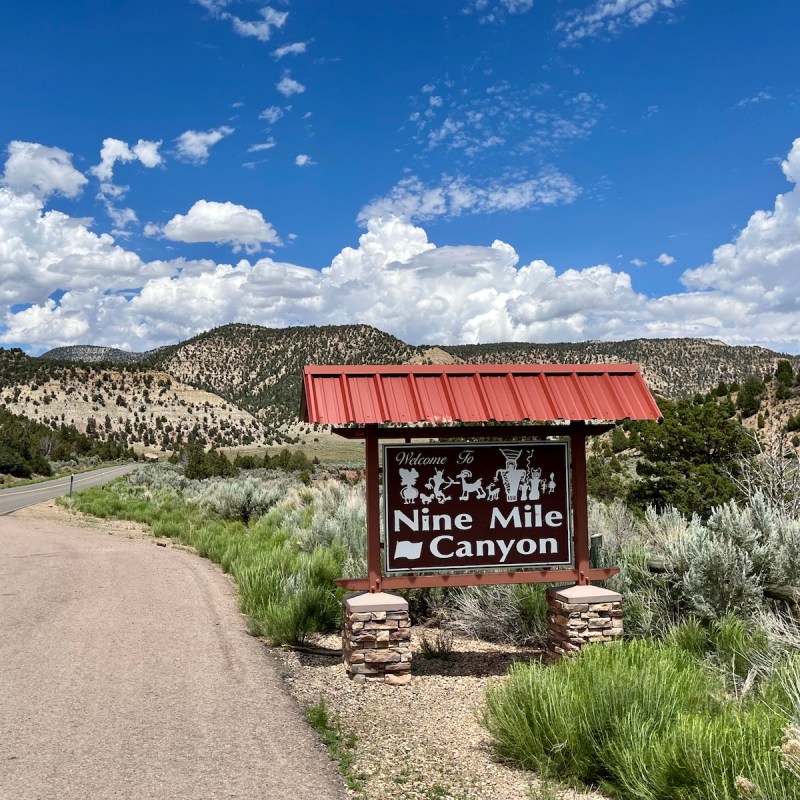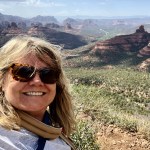
Most visitors to the wonderland of eastern Utah are probably already aware of the region’s fascinating dinosaur quarries, its iconic sandstone arches, and the lovely rivers that wind through its rugged canyons. What is less known, however, is something equally amazing: Nine Mile Canyon and its treasure trove of ancient art carved into the rocks and canyon walls.
Videos by TravelAwaits
Drive through this 46-mile canyon, and you will find wide-eyed owls peering at you through the centuries, early hunters in pursuit of bighorn sheep, and a hulking buffalo crouched along a rock ledge.
Nine Mile Canyon is known as “the world’s longest outdoor art gallery” for a reason. The petroglyphs that were left behind by the Fremont culture and the Ute people from A.D. 950–1250 are remarkable for their beauty, abundance, and stellar storytelling.
One of the advantages of road trips is that you often come across hidden gems that are as awe-inspiring as the things you initially set out to see. That was the case on my recent road trip through eastern Utah. I wasn’t aware of Nine Mile Canyon until I started researching my planned trip to the nearby Dinosaur National Monument. When I spotted an online image of the magnificent Great Hunt petroglyph, I knew I had to make a detour to the remote canyon in the region’s Book Cliffs.
Nine Mile Canyon is located off Utah’s Highway 191, not far from the Utah/Colorado border and near the towns of Helper and Price. The canyon is about 3 hours southeast of Salt Lake City and about 2 hours southwest of Dinosaur National Monument.
Here are 7 essential things to know before you explore the ancient petroglyphs of Nine Mile Canyon.

1. Expect To Be Wowed By The Petroglyphs
As a long-time resident of the U.S. Southwest, I’ve taken in many wonderful petroglyphs in Arizona, Nevada, and New Mexico. Places like Arizona’s Superstition Mountains and Nevada’s Red Rock Canyon feature fascinating examples of ancient rock art.
But for me, the petroglyphs in Utah’s Nine Mile Canyon stood out for a number of reasons.
First is the sheer number of petroglyphs in a relatively contained area. There are reportedly hundreds of art sites in the Nine Mile Canyon area, many of which are on private land and visible only through binoculars. But even if you take in just the petroglyphs that are marked with signs and parking areas along the main road, you’re in for a spectacular show.
Another thing that sets this area apart is the great variety of recognizable images, ranging from owls to bighorn sheep to animal claws.
I was also struck by the sharpness and vividness of the petroglyph images. While elsewhere, some works of rock art can be a bit faded and difficult to see, that is not the case on Nine Mile Canyon’s famous panels. The images are wonderfully visible and vibrantly hued.

2. The Great Hunt Is Stunning
The Great Hunt petroglyph, which features more than two dozen bighorn sheep and several bow-carrying hunters, is Nine Mine Canyon’s most enduring image. A sign at the site notes that the iconic scene has been replicated often in modern art pieces and has been featured in many publications. “The beautiful execution, detailed design and well-preserved condition make this panel one of the most recognized and famous rock art sites in Utah,” the sign says.
The Great Hunt is believed to have captured an actual hunting event that took place in late November or early December — the time when bighorn sheep herds meet up for the fall mating season. Many of the adult sheep are pictured with their young, and the sign notes that autumn would have been the only time of the year that rams, ewes, and lambs were all together in the same place.
Along with the animals, the mural includes a large, trapezoidal, horned person, a common feature of the classic Fremont rock art style. Humans are shown as hunters carrying bows and arrows.
The Great Hunt panel is located near the end of the 46-mile route and has a small adjoining parking area. The walk from the parking lot to the panel is less than a quarter-mile round trip, and it is along a flat, easy path.

3. Don’t Miss The Fascinating Owl Panel
At about the halfway point of the canyon drive is the Owl Panel, a less-known but equally captivating petroglyph that features a collage of owls and other animals.
While I was prepared for the impact of The Great Hunt, the Owl Panel took me by surprise. Its centerpiece owl is large and eye-catching, with peaked horns, widespread wings, and two different eye designs — one with a cross and one with an oval pupil.
The panel also includes smaller owls, handprints, and images of bighorn sheep, rabbits, and a bear claw.
The Owl Panel is located about a quarter mile from the trailhead parking area. Although the trail is a bit rocky and uneven, it is a fairly easy walk.

4. Major Rock Art Sites Are Well Marked
Nine Mile Canyon’s most well-known petroglyphs are all marked with signs and have parking areas or small pullouts along the road. If you have just a few hours to explore the canyon, it is best to limit your stops to the major sites.
Among the signed sites are the Great Hunt, the Owl Panel, the First Site, Pioneer Cabin, Balance Rock, and Daddy Canyon. They are all great places to stop and explore.
There are plenty of other rock art sites in Nine Mile Canyon as well. You could easily spend days exploring all of the hidden petroglyphs. If you have the time and interest, the best advice is to drive slowly along the road and keep your eyes peeled on the rock walls for animal figures, trapezoid-shaped people, and squiggly lines etched in the rock.

5. It’s 46 Miles Long, Not 9 Miles
Based on its name, it would be easy to assume that Nine Mile Canyon is 9 miles long, but that’s not the case. The canyon drive actually runs about 46 miles one-way and 92 miles roundtrip.
According to internet accounts, Nine Mile Canyon got its name when an early topographer did a nine-mile triangulation drawing and named the area Nine Mile Creek.
6. There Are No Services Available In The Canyon
Nine Mile Canyon is remote, and it passes through extremely rugged terrain. There are no gas stations, convenience stores, or restaurants along the 46-mile route.
That means that drivers should be sure to gas up in the nearby towns of Wellington, Price, or Helper and stock up on necessary supplies. Travelers are advised to have at least a liter of water per person, and more if longer hikes are planned.
It’s also a good idea to have snacks and a picnic lunch to enjoy along the way. The Cottonwood Glen Picnic area is a great place along the route for stopping to stretch your legs, use the pit-toilet restrooms, and enjoy a picnic in the covered areas. Visitors can also explore an old pioneer cabin and the grounds that include a well, cellar, and old chimney.
Pro Tip: I found my cell phone service and data for mapping to be spotty along the Nine Mile Canyon drive, so drivers should plan accordingly.

7. The Road Is Paved, But Winding And Wavy
You’ll find a smoothly paved road for the 46-mile length of the Nine Mile Canyon, but that doesn’t mean it’s all smooth sailing. The route includes many curves, as well as a number of ups and downs as the road climbs hills and plateaus.
The road surface also features numerous dips through drainage areas that require drivers to slow down significantly. Because the dips can be somewhat steep, it pays to heed the 10-mile-per-hour signs. In addition, the road runs alongside rangeland for cattle, and signs warn drivers that they might encounter cows on the road.
When To Visit Nine Mile Canyon
Summers in eastern Utah tend to be hot, with average highs in the 80-and-90-degree Fahrenheit range from June through August. Spring and fall are arguably the best seasons to visit, with May and September posting average highs in the 70s, and April and October in the 60s.
How To Get To Nine Mile Canyon
To drive the Nine Mile Canyon, local experts recommend entering the route near the small town of Wellington (at the junction of Highway 191 and Soldier Creek Road), driving the 46 miles to where the pavement ends, and then doubling back the same way. Another alternative is available as a loop trip by taking the road through Gate Canyon to the town of Myton, west of Vernal.
Pro Tips
- Restrooms with pit-style toilets are available at several locations along the canyon route, including the Cottonwood Glen and the Daddy Canyon Trailhead.
- Camping is not allowed on any of the public land in the canyon, but cabins and campsites are available at the privately owned Nine Mile Ranch.
- The petroglyphs of Nine Mine Canyon are fragile, irreplaceable, and protected by law. Visitors should not touch the rock art and the surfaces surrounding the area and should not collect or disturb anything in the area.
